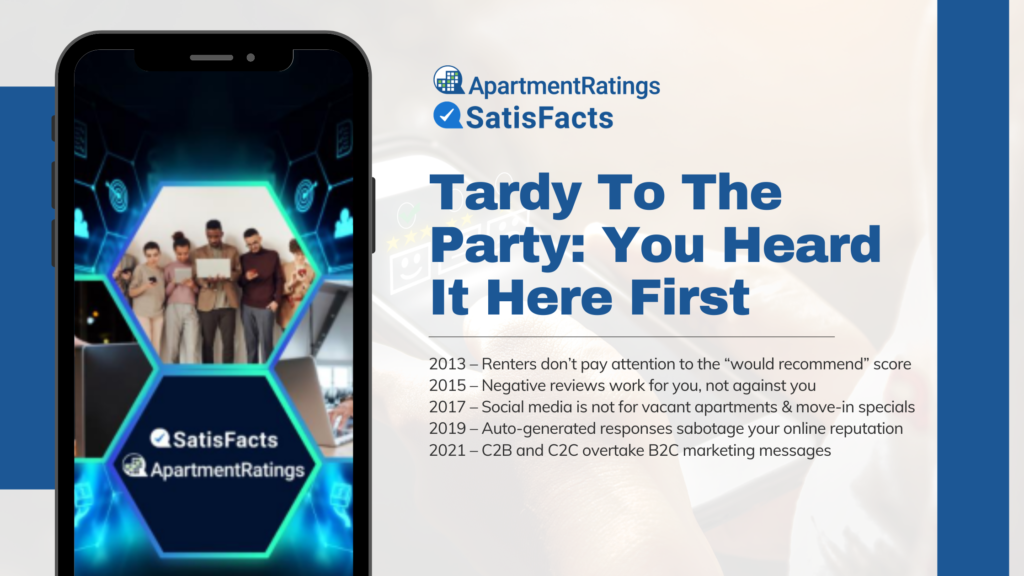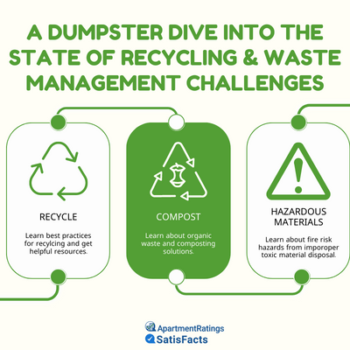
December marked my 10th year at ApartmentRatings and SatisFacts…oh my, how times have changed! I remember the first day, which also happened to be my first day on the supplier side of the industry. Up to that point, my career in multifamily had been either onsite or at the corporate level as an operator; all leading to a limited perspective regarding the wants and needs of renters. I was also unaware how these wants and needs varied from market to market and the impact they had on leasing and renewal decisions.
Over the years, I have learned to not only analyze data, but to also listen to what the data was telling me. Anyone can crunch numbers all day, but to detect patterns, discern sentiment and correlate renter trends alongside those found outside of our industry have proven to be invaluable skills. I have also been fortunate to work with top-notch team members who are collaborative and willing to brainstorm and swim through the minutiae of decimals and percentages, resulting in predictions we made long ago that are just now being discovered by others. Here are 5 industry trends we were the first to introduce.
2013 – Renters don’t pay attention to the “would recommend” score
We consistently check in with visitors to ApartmentRatings to gather feedback on what is most important and use what we’ve learned to create a better user experience. In 2013 we asked visitors to rank which review criteria was most important. At that time, “safety” was cited as the most important and “recommend score” was the least important. This piqued our interest as it was commonly thought recommendations would surely drive interest to a community.
Digging more into this finding, we realized that half of the top 10% trafficked communities had a recommend score under 50%. This created a high-alert moment and we began writing articles and building webinars around topics such as the importance of looking beyond the basic practice of reputation management. Developing strategies for exceptional-level service was our recommendation to motivate residents to write reviews that were more like stories, with details of their experiences as opposed to attempting to reach a high “would recommend” percentage.
In the years following, every ApartmentRatings visitor study resulted in the same sentiment; in fact, the number of renters ignoring the recommendation score kept growing each round. With 7 years of solid data, it was a no-brainer for us to remove the “would recommend” percentage from our overall rating calculations; much to the dismay of those who were scraping it from our website to use elsewhere.
2015 – Negative reviews work for you, not against you
Brightlocal determined in its 2014 Local Consumer Review Survey that 92% of respondents would use a business if it had a 4-star rating, and only 8% expected a business to have a perfect 5-star rating. Wondering if the same held true when it came to apartments, we again asked visitors to ApartmentRatings for their input. In 3 rounds conducted over a 90-day period, our findings were right in line with Brightlocal’s.
If you believe a negative review will sabotage your ability to secure a lease or renewal, think again. When asked in our 2015 Online Renter Study “would you trust a review site with all or mostly positive reviews?”, 49.7% said no. This number currently stands at 58%, proving renters expect to encounter negative reviews. They know the odds of a community being able to provide a five-star experience, 100% of the time is highly unlikely and may even be turned off should a community try to suggest otherwise.
2017 – Social media is not for vacant apartments and move-in specials
In 2017, our Online Renter Study determined that social media was not a key influencer with renters. During the search for a new home, only 14.1% of renters said they used a community’s social media page as a source for information. And when asked if the community’s social media presence factored into the overall decision to lease, the consensus was “no”; placing social media at #46 out of 48 in terms of importance.
What got our attention back then was how existing residents felt about a community’s use of social media. After conducting our annual perception of value correlation analysis, we were floored at the results. The 2nd most important driver for perception of value was social media. What stunned us even more was social media was never among the top 5 drivers and then suddenly, it shot up from #26 to #2.
Why the dramatic shift? 2017 was the year that many late-Millennials and early-Gen Zers were reaching adulthood, striking out on their own and becoming first-time renters. This new crop of renters signaled a change in content strategies; Millennials wanted content that was share-worthy and Gen Z wanted content that was entertaining.
2019 – Templates and auto-generated responses sabotage your online reputation
This was the year when online ratings and reviews surpassed word of mouth as the #1 most trusted source, making responses to those reviews even more critical. Renters believed the quality of customer service they would experience as a resident could be determined by how the management team chooses to respond, and not respond to a review. As found in our 2019 Online Renter Study, when asked “how does it make you feel when a management team professionally responds to a review,” the most chosen answer was “they really care about their residents”.
Those who are reading reviews are doing so because they are interested in touring or possibly one step closer to making a decision. Repeat and overused phrases may be an efficient strategy for responding but they come across as cold and emotionless. Many think it’s easier to have a bank of ready-to-go responses or to respond in bulk, but as renters tend to read an average of 6-10 reviews per community, repeat and formulaic responses are complete turn-offs.
Armed with this information, we officially rolled out our Review Responder service, providing companies with access to a team of industry experts dedicated to crafting custom responses without a template in sight.
2021 – C2B and C2C overtake B2C marketing messages
Leading up to this discovery, we tracked a rising trend among renters where company-driven marketing messages resulted in a loss of trust. This growing indifference towards an outward-facing strategy can be seen in just about every industry and multifamily is no exception. Companies with undeveloped C2B (consumer-to-business) and C2C (consumer-to-consumer) strategies are years behind the shift in renter preferences, and the pandemic further deepened this apathy by impacting the resident experience, causing many to reconsider their current living situations.
The importance of a community having a resident survey/feedback program as a renewal motivator has grown 17.6% in 2021 when compared to our Online Renter Study from 2011, and for the second time in a row, online reviews are the most trusted source. Renters, not companies, now control the outcome of what other renters will decide to do with their hard-earned dollars. And for those in search of a new home, they want raw, transparent details; even if that information is less than perfect.
Our epIQ Index quantifies the relationship between renters and their communities. Building features into ApartmentRatings such as the ability to rate a manager’s review response and allowing visitors to ask questions about a community enable renters to trade knowledge with each other, thus facilitating the sense of community that everyone is looking for.
Transforming feedback into actionable insights while helping our client partners stay in step with renters is what we’re all about here at ApartmentRatings and SatisFacts. And as for myself, getting nerdy over numbers is still one of the most exciting parts of my job. Stay tuned for more predictions because current data is leading us yet again in new directions. Remember, you heard it here first!



